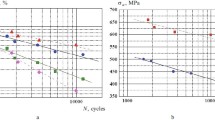Abstract
The plane strain fracture toughness values,K Ic , the fatigue crack growth rates and the tensile properties of M-50 and 18-4-1 high speed steels have been measured as a function of tempering temperature. The M-50 was a vacuum arc remelted grade (VIM-VAR) and the 18-4-1 an electroslag grade, and both are used in mainshaft gas turbine bearings. At the usual hardness for bearings, Rockwell C 62, 18-4-1 exhibited a slightly higher fracture toughness (21 MPa·m1/2) than M-50 (18 MPa·m1/2). The fatigue crack growth rates were very similar, and in the slow growth region followed the usual power law,dC/dN=(ΔK)m withm=3 to 4. The crack propagation rates were still significant at values as low as ΔK=5 MPa·m1/2. SEM studies of the fracture surfaces showed complex transgranular fracture paths for both steels. The tensile strengths and the elongations of M-50 were somewhat higher than the corresponding values for 18-4-1 but the yield strengths of the two steels were similar. The microstructures of these steels were markedly different, with M-50 exhibiting 2.6 vol pct undissolved carbides and the 18-4-1 showing 15.2 vol pct carbides, but the fatigue and fracture behaviors were similar.
Similar content being viewed by others
References
W. E. Littman and R. L. Widner:J. Basic Eng., 1966, vol. 88, pp. 624–36.
T. E. Tallian:ASLE Trans, 1967, vol. 10, pp. 418–39.
B. L. Averbach:Proc. Fourth Int. Conf. on Fracture, D. Taplin, ed., vol. 1, pp. 201–213, University of Waterloo Press, Waterloo, Canada, 1977.
K. Eriksson:Scand. J. Metall., 1973, vol. 2, pp. 197–203.
A. R. Johnson:Met. Trans. A, 1977, vol. 8A, pp. 891–97.
J. A. Rescalvo and B. L. Averbach: Unpublished research, MIT, Cambridge, MA 1978.
J. E. Bridge, Jr., G. N. Maniar, and T. V. Philip:Met. Trans., 1971, vol. 2, pp. 2209–14.
F. Kayser and M. Cohen:Met. Prog., 1952, vol. 61, pp. 79–85
W. Hume-Rothery:The Structures of Alloys of Iron, p. 297, and pp. 257–63, Pergamon Press, Oxford, 1966.
T. Mukherjee: ISI Publication 126, pp. 80–96, 1970.
J. Durnin and K. A. Ridal:J. Iron Steel Inst. 1968, vol. 206, pp. 60–67.
J. R. Rice and M. A. Johnson:Inelastic Behavior of Solids, M. F. Kanninen et al., eds., pp. 641–70, McGraw-Hill, New York, 1970.
Author information
Authors and Affiliations
Rights and permissions
About this article
Cite this article
Rescalvo, J.A., Averbach, B.L. Fracture and fatigue in M-50 and 18-4-1 high speed steels. Metall Trans A 10, 1265–1271 (1979). https://doi.org/10.1007/BF02811982
Received:
Issue Date:
DOI: https://doi.org/10.1007/BF02811982




